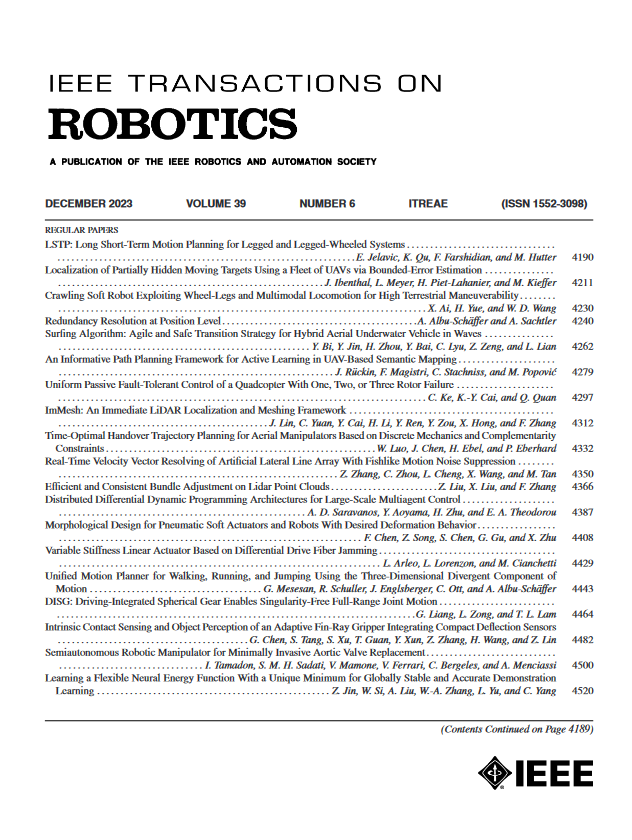A Model Predictive Capture Point Control Framework for Robust Humanoid Balancing Via Ankle, Hip, and Stepping Strategies
IF 9.4
1区 计算机科学
Q1 ROBOTICS
引用次数: 0
Abstract
The robust balancing capability of humanoids is essential for mobility in real environments. Many studies focus on implementing human-inspired ankle, hip, and stepping strategies to achieve human-level balance. In this article, a robust balance control framework for humanoids is proposed. First, a model predictive control (MPC) framework is proposed for capture point (CP) tracking control, enabling the integration of ankle, hip, and stepping strategies within a single framework. In addition, a variable weighting method is introduced that adjusts the weighting parameters of the centroidal angular momentum damping control. Second, a hierarchical structure of the MPC and a stepping controller was proposed, allowing for the step time optimization. The robust balancing performance of the proposed method is validated through simulations and real robot experiments. Furthermore, a superior balancing performance is demonstrated compared to a state-of-the-art quadratic programming-based CP controller that employs the ankle, hip, and stepping strategies.基于踝关节、髋关节和步进策略的鲁棒人形平衡模型预测捕获点控制框架
类人机器人强大的平衡能力对其在真实环境中的移动能力至关重要。许多研究集中于实施人类启发的踝关节、髋关节和步进策略,以达到人类水平的平衡。本文提出了一种鲁棒的类人机器人平衡控制框架。首先,提出了一个模型预测控制(MPC)框架,用于捕获点(CP)跟踪控制,使踝关节、髋关节和步进策略集成在一个框架内。此外,还介绍了一种可调整质心角动量阻尼控制权重参数的变权方法。其次,提出了MPC的分层结构和步进控制器,允许步进时间优化。通过仿真和真实机器人实验验证了该方法的鲁棒平衡性能。此外,与采用踝关节、髋关节和步进策略的最先进的基于二次规划的CP控制器相比,证明了优越的平衡性能。
本文章由计算机程序翻译,如有差异,请以英文原文为准。
求助全文
约1分钟内获得全文
求助全文
来源期刊

IEEE Transactions on Robotics
工程技术-机器人学
CiteScore
14.90
自引率
5.10%
发文量
259
审稿时长
6.0 months
期刊介绍:
The IEEE Transactions on Robotics (T-RO) is dedicated to publishing fundamental papers covering all facets of robotics, drawing on interdisciplinary approaches from computer science, control systems, electrical engineering, mathematics, mechanical engineering, and beyond. From industrial applications to service and personal assistants, surgical operations to space, underwater, and remote exploration, robots and intelligent machines play pivotal roles across various domains, including entertainment, safety, search and rescue, military applications, agriculture, and intelligent vehicles.
Special emphasis is placed on intelligent machines and systems designed for unstructured environments, where a significant portion of the environment remains unknown and beyond direct sensing or control.
 求助内容:
求助内容: 应助结果提醒方式:
应助结果提醒方式:


